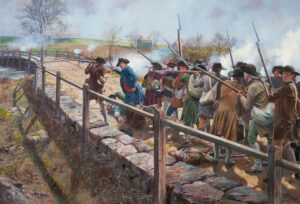Originally organized as a glider infantry unit in World War II, the 187th Infantry Regiment fought in the Korean War as part of an airborne regimental combat team. Later, in the Vietnam and Persian Gulf Wars, elements of the 187th fought as helicopter-borne units with the 101st Airborne Division. Throughout its history, the 187th has served with distinction in combat and accomplished a number of firsts, particularly during the Korean War.
The 187th was constituted 12 November 1942 in the Army of the United States as the 187th Glider Infantry Regiment and activated 25 February 1943 at Camp Mackall, NC, as an element of the 11th Airborne Division. After training at Camp Polk, LA, the regiment staged at Camp Stoneman, CA, on 29 April 1944 until it left the port of San Francisco on 6 May 1944. The regiment arrived in New Guinea with the rest of the 11th Airborne on 29 May 1944.
After conducting airborne training, practice amphibious landings, and jungle maneuvers, the 187th departed New Guinea on 11 November 1944 and arrived at Leyte Island, Philippines, on 18 November, landing at Bito Beach. While on Leyte, the 187th saw heavy fighting and suffered heavy casualties taking Purple Heart Hill. On 31 January, the 187th performed a para-amphibious assault at Nasugbu Bay on Luzon and fought their way into the jungle to Tagaytay Ridge. For their actions at Tagaytay Ridge, the soldiers of the 187th earned a Presidential Unit Citation. During the 11th Airborne Division’s assault on Manila in February 1945, the 187th captured Fort McKinley.
After the liberation of Manila, the 187th took part in heavy fighting throughout Luzon. The regiment fought for Hill 600 8-11 March and later seized the heavily defended Mount Macolod. After the final Japanese strongholds on Luzon were eliminated in June 1945, the 187th landed on Okinawa on 12 August. On 30 August, after Japan’s surrender, the 187th landed at Atsugi Airfield near Tokyo to serve as occupation forces. The soldiers of the 187th were the first foreign troops to enter Japan in 2,000 years.
During the occupation of Japan, the 187th and the rest of the 11th Airborne were posted in northern Honshu and Hokkaido. It was during the occupation that the Japanese gave the 187th its nickname, “Rakkasans,” which loosely translates to “falling umbrella.” After completing occupation duties, the 187th was allotted to the Regular Army in 1948 and later reorganized and redesignated the 187th Airborne Infantry in 1949.
With the outbreak of the Korean War in June 1950, the 187th, now a parachute unit, was called up for duty. Under the command of COL Frank S. Bowen, the 187th was paired up with the 674th Field Artillery Battalion and supporting units to form the 187th Airborne Regimental Combat Team (RCT).
The RCT left Camp Stoneman, CA, on 6 September 1950 and arrived in Japan on 20 September. Four days later, it was airlifted to Kimpo Airfield near Seoul, where it successfully cleared the Kimpo Peninsula.
From Kimpo, the 187th made an airborne assault at Sunchon-Sukchon, thirty miles north of Pyongyang, to cut off an estimated 30,000 retreating North Korean soldiers and rescue U.S. POWs believed to be with those forces. The drop included a number of firsts, including the first combat drop from C-119s and the first successful heavy drop of 105mm howitzers, jeeps and other equipment. During the Eighth Army’s retreat after the Chinese intervened, the 187th and the British Commonwealth Brigade served as the Eighth Army’s rearguard.
Throughout the rest of the Korean War, the 187th saw heavy fighting, particularly at Wonju in February 1951. In March 1951, the RCT made another airborne assault at Munsan-ni. In 1952, the 187th was withdrawn to Japan as part of the U.S. Far East Command reserve. Troops of the 187th later helped subdue POW camp riots in June 1952. For its service in Korea, the Rakkasans were awarded four unit citations, and three soldiers were awarded the Medal of Honor. In total, the 187th suffered 2,115 casualties in Korea, including 442 killed in action.
In 1956 the 187th was assigned to the 101st Airborne Division. The following year, the regiment was reorganized as the 187th Infantry, a parent regiment under the Combat Arms Regimental System.
During the Vietnam War, the 3rd Battalion, 187th Infantry, fought with the 101st Airborne Division. During its service in Vietnam, primarily in the Central Highlands and the A Shau Valley, the Rakkasans were awarded twelve campaign streamers and nine unit decorations, including a Presidential Unit Citation for the battle of Dong Ap Bia Mountain, better known as Hamburger Hill.
In September 1990, the three battalions of the 187th began deploying to Saudi Arabia as part of Operation Desert Shield. Once ground operations began in late February 1991, the 187th took part in the largest and deepest air assault in history, striking 155 miles behind enemy lines into the Euphrates River Valley.
Today, the 187th continues to serve with the 101st Airborne Division at Fort Campbell, KY. The regiment’s three battalions are currently assigned to the division’s 3rd Brigade.
© The Army Historical Foundation



